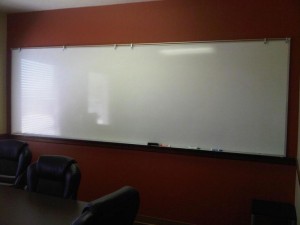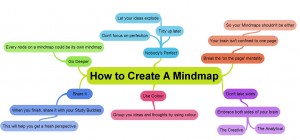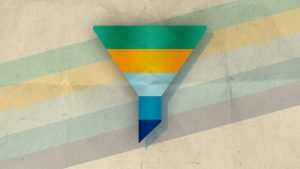Fleshing out ideas
Your first idea isn’t always your best idea. This is especially true for complex, original creative projects. And nothing beats brainstorming for coming up with fresh ideas and refining your concepts.
Brainstorming is a terrific technique to ensure that ideas are complete and interesting. If your projects need a Concept or Discovery phase, that’s the time to get the most out of brainstorming.
Your first idea isn't always your best idea. Share on XUsing a whiteboard

Before developing websites, I worked as an interactive game designer for several years in small studio environments. We used to brainstorm game ideas quite a bit. The whiteboard was our favorite tool.
One of the running jokes was to get your bad ideas out of the way first. We’d write dozens of ideas on the whiteboard. Then we’d get rid of the bad ones (and replace them with the keepers). We would end up with a list of some pretty good material.
It’s a process that doesn’t expect you to keep your first ideas. It forces you to think and keep only your best ideas. It’s OK to start with a hundred ideas and walk away with a handful. It’s not about quantity. Brainstorming ideas on the whiteboard gets your creative juices flowing. It helps you identify the winners.
Mind mapping
Brainstorming with a group is a lot of fun. But it’s not always the way that brainstorming happens. You don’t always have group resources. Sometimes you have to do it on your own.
When I first started brainstorming as a freelance designer, I’d write a single word in the middle of a piece of paper. Then I’d start some mind mapping. I’d draw a circle around the original word and write supporting words around it. I’d fill a piece of paper with word associations and create a holistic picture. These mind maps illustrated relationships between topics and categories. This technique was especially good for coming up with keywords for web pages.
The problem I have with mind mapping is that it forces a hierarchy as you go. It can be difficult to change and reorder associations. I’m sure there are software apps that make this process a little easier. But on paper or the whiteboard, it can be challenging. Mind mapping started out as my go-to technique but I grew out of using mind maps altogether. They’re great for free association. But when it comes to comprehensive lists on a topic, there are better tools and techniques.
Using Trello to brainstorm

A few years ago I discovered an online organizational tool called Trello. Trello forever changed the way I approached brainstorming. For me, it trumps the whiteboard and word association techniques. It gives you the ability to do word association and categorization at the same time.
The ability to categorize your ideas as you go is a big help when brainstorming. Sometimes it’s difficult to know whether something is a topic or its own category. Trello allows you to re-categorize and shuffle ideas without erasing and rewriting them.
Using Trello is like card sorting on a virtual tackboard. You can create vertical lists that act as categories. Each list can have an unlimited number of cards. It’s simple to reorder cards in a list, move cards from one list to another, and rename any card or list. It’s the most flexible brainstorming or mind mapping tool that I’ve used so far. Trello is actually much more than a list-making tool. But I like it for brainstorming and idea generation more than anything else.
@Trello is a great app for #brainstorming. Share on XBenefit of brainstorming
There are a lot of different ways to brainstorm. I prefer software that helps me to categorize and reorder my ideas.
Regardless of the tools, brainstorming is an awesome step in the creative process. It allows ideas to form outside your mind. Brainstorming gives birth to order and clarity. It takes things beyond the early conceptual stew.
If nothing else, brainstorming gets you past the “blank page.” It’s OK to start with almost anything. Brainstorming is easy to do and can help almost any creative effort get off the ground.








